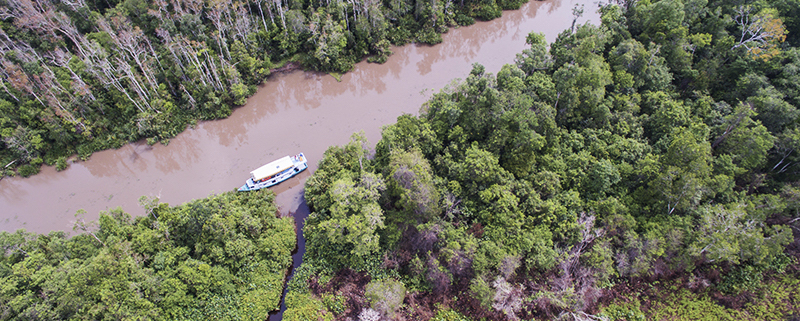Highs and Lows
Today I am flying my drone from the boat to photograph the river with its close approximation to palm oil trees. We will then either hike or take a motor bike almost 10 kilometers (over 6 miles) to a huge area where primary forest burned down. My forest guide Aidi was on a team there working to put out the fires. In the end, we took motor bikes. That would have been a L-O-N-G walk in the forest. It was fun riding through the rain forest – and much cooler….
 …but upon arrival to the rainforest’s “new” edge, the fun was short lived. I was able to get some images from the drone that were interesting and disheartening to all of us.
…but upon arrival to the rainforest’s “new” edge, the fun was short lived. I was able to get some images from the drone that were interesting and disheartening to all of us.
 The fires were more devastating than anyone knew. When I finally showed these images to Dr. Galdikas, she was shocked and quite upset.
The fires were more devastating than anyone knew. When I finally showed these images to Dr. Galdikas, she was shocked and quite upset.
Anyway, after flying we decided to go to a feeding station where the forest rangers put out bananas and cassava for the habituated Bornean orangutans (Pongo pygmaeus) that were released at some time earlier (either as a result of the illegal pet trade or translocation). One big male cautiously came to the site – he was not the resident dominant male in this territory and approached cautiously. After he scattered the females and their young that were feeding, he sat and fed for a long time. All of a sudden, he started to make the “long call”. It is a sound unlike any other – Theo mentioned this in his post about Kusase. This male then jumped off the platform and went after a young female. To my utter surprise, he raped her in front of us. She didn’t try to fight him off (maybe there was no point as he was HUGE?) and when it was all over, they sat and fed together quietly.
 If you have a chance, please look at my previous blog about Sumatran orangutans to compare the photo of the Sumatran dominant male that I posted. They look so different. This dominant Bornean male has big flanged cheek pads on the sides of his face and a large pendulous throat sack under his chin. The shape of his cheek pads also differ from those of the flanged Sumatran male. Also, the Sumatran males don’t have the throat sack. You can visibly see the difference between these two species.
If you have a chance, please look at my previous blog about Sumatran orangutans to compare the photo of the Sumatran dominant male that I posted. They look so different. This dominant Bornean male has big flanged cheek pads on the sides of his face and a large pendulous throat sack under his chin. The shape of his cheek pads also differ from those of the flanged Sumatran male. Also, the Sumatran males don’t have the throat sack. You can visibly see the difference between these two species.
Orangutans LOVE bananas. They don’t get them in the primary or secondary forests here and so they are a favorite treat at the feeding platforms:
 Today has been a day of highs and lows (literally) with the drone – but the faces of these wonderful animals keeps me focused on why I am here – to ignite the fire to fight against the palm oil companies. It is becoming increasingly more clear every day that I MUST stop buying products with palm oil as the ingredient. It is the most important thing that I can do to reduce the demand for this insidious product.
Today has been a day of highs and lows (literally) with the drone – but the faces of these wonderful animals keeps me focused on why I am here – to ignite the fire to fight against the palm oil companies. It is becoming increasingly more clear every day that I MUST stop buying products with palm oil as the ingredient. It is the most important thing that I can do to reduce the demand for this insidious product.
Jami Tarris



Leave a Reply
Want to join the discussion?Feel free to contribute!